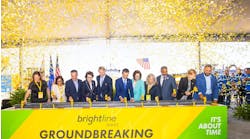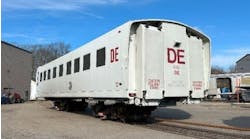Gov. Pat Quinn, D-Ill., issued the following news release:
Governor Pat Quinn today announced a partnership between the University of Illinois, the Illinois Department of Transportation and a special advisory group to study the feasibility of 220-mph passenger rail service between Chicago, Urbana-Champaign and beyond. The study will complement the ongoing construction of a regional 110-mph network that will connect Chicago to 40 cities in the Midwest, while supporting Governor Quinn's vision to create jobs, enhance regional mobility and improve the environment by expanding passenger rail in Illinois.
"Illinois is leading the nation with our work to expand high-speed and passenger rail," said Governor Quinn. "This study will provide greater insight into how we can make 220-mph rail service a reality. An expanded and improved rail network will boost our position in the global economy and create thousands of jobs."
The study will explore the potential costs and benefits of establishing 220-mph service between O'Hare International Airport, downtown Chicago, McCormick Place, and Champaign-Urbana. It will also look at extending the corridor in the region to cities south of Champaign-Urbana, including St. Louis and Indianapolis.
Leading the study will be University of Illinois at Urbana-Champaign professor Christopher P.L. Barkan, director of the school's railroad engineering program and one of the nation's top rail scholars. Contributing will be University of Illinois at Chicago Urban Transportation Center director Stephen Schlickman, former executive director of the Regional Transportation Authority. Their findings, made possible through a $1.25 million contribution from the Illinois Jobs Now! capital program, is expected to be complete and presented to Governor Quinn in late 2012.
"I'm delighted that the University of Illinois can lend its vast expertise to this crucial study, and I'm grateful to the governor and other leaders in the state for their support of this important work," said University of Illinois President Michael Hogan. "High-speed rail is transformational in its effect on economic development, personal mobility and on our society, in general. It's an idea that is well worth a hard look. The benefits to the University of Illinois alone cannot be overstated."
In addition to offering corridor location recommendations, the study will offer estimated ridership projections, economic impacts, construction costs and financing options. Assisting in the effort will be an advisory group composed of transportation experts, rail advocates, labor leaders, and regional planners who will provide input during the course of the study.
The members of the special advisory group include:
* State Senator Martin Sandoval (D-Chicago)
* State Representative Elaine Nekritz (D-Northbrook)
* Rick Harnish, Midwest High Speed Rail Association
* Kevin Brubaker, Environmental Law & Policy Center
* Joan Murphy, Cook County Commissioner (6th)
* Bob Guy, United Transportation Union
* J.D. Ross, Regional Transportation Authority Board of Directors
* MarySue Barrett, Metropolitan Planning Council
* Jack Guthman, Shefsky & Froelich Ltd
Governor Quinn and IDOT broke ground last year on the state's signature high-speed line between Chicago and St. Louis. Speeds of 110-mph along parts of the corridor will be reached as early as next year. A completed Midwest network will create over 57,000 jobs, including 24,000 in Illinois. In addition to Chicago-St. Louis, the Obama Administration has provided funding for the Chicago to Iowa City via the Quad Cities and Chicago to Detroit corridors. Last month, the U.S. Department of Transportation also awarded additional funding to expand the Midwest's new equipment fleet with modern, domestically-built locomotives and railcars.
Copyright Targeted News Services
TNS C-BhaS 110603-mv45-3417966
Copyright 2008 LexisNexis, a division of Reed Elsevier Inc. All rights reserved.
Terms and Conditions | Privacy Policy


